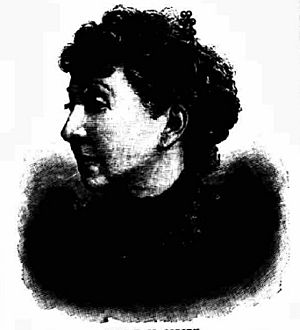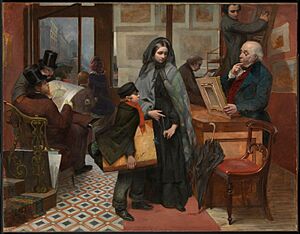Emily Mary Osborn facts for kids
Quick facts for kids
Emily Mary Osborn
|
|
|---|---|
 |
|
| Born | 11 February 1828 Kentish Town, London
|
| Died | 25 April 1925 (aged 97) St John's Wood, London
|
| Nationality | British |
|
Notable work
|
Nameless and Friendless (1857) |
| Spouse(s) | None |
Emily Mary Osborn (born 1828, died 1925) was a talented English painter from the Victorian era. She was known for her beautiful pictures of children and everyday life scenes, especially paintings that showed women facing challenges.
Contents
Emily Osborn's Early Life and Art Training
Emily Osborn was born in Kentish Town, London, on February 11, 1828. She was the oldest of nine children. Her father was a reverend, and her mother, Mary, loved painting very much.
When Emily was about five, her family moved to West Tilbury. Emily later said there wasn't much natural beauty there. However, her mother encouraged her art. She was proud of the clever portraits Emily drew of her brothers and sisters. Emily's mother had always wanted to study art professionally herself.
As a teenager, Emily even found a creative way to make her own paints. She put flower petals into bottles with a little bit of spirits of wine.
Moving to London and Art School
In 1842, when Emily was about 14, her family moved back to London. This made Emily very happy! She felt she now had a chance to become an artist.
She started taking evening classes at the Dickenson academy in Maddox Street. Her teacher was John Mogford. After three months, her father wanted her to stop lessons. This was probably because of money. But one of her teachers, J.M. Leigh, offered to teach her privately.
So, Emily studied privately with J.M. Leigh. She later continued at his academy in Newman Street for a year.
Showing Her Art to the World
In 1851, at just 17 years old, Emily Osborn began showing her artwork. She displayed her paintings at the annual Royal Academy exhibition. She continued to show her work there for over 40 years, until 1893.
In 1868, Emily's mother passed away. For two years, Emily did not create any major artworks. After that, she and her sister spent six months helping sick and wounded people during the Franco-Prussian War.
Emily also traveled and painted. She visited Venice and Algeria, and her paintings from these trips became well-known. She also painted scenes from the Norfolk Broads in England.
Emily Osborn never married. She passed away at the age of 97 on April 14, 1925. She lived in London in a home she shared with Mary Elizabeth Dunn for many years.
What Emily Osborn Painted
Like other female artists of her time, Emily often found ideas for her paintings in books and stories. Paintings based on literature were a way for women artists to show their skills. This could also help them get other jobs, like painting portraits or landscapes.
Emily's paintings were often more complex than others. They usually showed many people, which proved her great skill. For a while, her art also showed the difference between young and old, like in Tough and Tender (1862).
Paintings with a Message
Emily Osborn became most famous for her paintings that seemed to teach a lesson. She was very good at creating emotional scenes. Her subjects were often young women and children.
Her work was seen as having a moral or educational message. It felt real and showed true-to-life situations. For example, The Governess (1860), For the Last Time (1864), and Half The World Knows Not How the Other Half Lives (1864) were all thought to teach important lessons.
There were also many stories and paintings about middle-class women who had to earn their own money. Emily Osborn's famous painting, Nameless and Friendless (1857), also explored this theme.
Nameless and Friendless Painting
Emily Osborn's most famous painting is Nameless and Friendless (1857). Some people have called it "The most clever of all Victorian widow pictures."
The painting shows a woman who has recently lost her husband. She is trying to make a living as an artist. She is offering a picture to an art dealer. Meanwhile, two wealthy men on the left are staring at her.
This painting was very important for its time. In the 1850s, many middle-class women started moving to London cities. Women began to walk the streets more freely and use public transportation. This created new chances for women. But it also led to many discussions about how women should behave in public. Nameless and Friendless is one of the few paintings by a woman that showed these new city experiences during the 1850s.
Gallery







